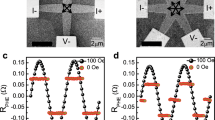Abstract
The possibility of controlling stray magnetic fields around conductive layered ferromagnet-containing systems is analyzed. It is shown that different magnetic-field patterns can be implemented depending on the layer parameters and current. Calculation is based on a simplified model where a real stray field is approximated by a system of effective point magnetic charges at the sample surface. In the case of in-plane magnetization, the induced stray field partially screens the external one. This screening is less effective when the applied magnetic field is replaced with electric current. In the case of out-of-plane magnetization, the stray field is concentrated near the domain walls and the sample edges where it can be extremely strong. A mechanism for controlling the different components of a stray field via domain-wall rotation by a current-induced magnetic field is proposed. Numerical estimation shows that the expected ratio of the stray field to current is close to experimental values obtained in numerous transport measurements and usually ascribed to proximity effects (exchange interaction between carriers in adjacent layers). The proposed alternative origin of the effective field should be taken into account when analyzing spin Hall effect and similar spintronics problems.






Similar content being viewed by others
REFERENCES
M. D. Stiles and A. Zangwill, Phys. Rev. B 66, 014407 (2002).
I. M. Miron, K. Garello, G. Gaudin, P.-J. Zermatten, M. V. Costache, S. Auffret, S. Bandiera, B. Rodmacq, A. Schuhl, and P. Gambardella, Nature 476, 189 (2011).
P. M. Haney, H.-W. Lee, K.-J. Lee, A. Manchon, and M. D. Stiles, Phys. Rev. B 88, 214417 (2013).
E. Martinez, S. Emori, and G. S. D. Beach, Appl. Phys. Lett. 103, 072406 (2013).
J. Ryu, S. Lee, K.-J. Lee, and B.-G. Park, Adv. Mater. 32, 1907148 (2020).
I. A. Ado, O. A. Tretiakov, and M. Titov, Phys. Rev. B 95, 094401 (2017).
H. J. Williams and W. Shockley, Phys. Rev. 75, 178 (1949).
R. Aleonard, P. Brissonneau, and L. Neel, J. Appl. Phys. 34, 1321 (1963).
E. Lopez, C. Aroca, and P. Sanchez, J. Magn. Magn. Mater. 36, 175 (1983).
E. Salhi and L. Berger, J. Appl. Phys. 76, 4787 (1994).
N. Smith, W. Doyle, D. Markham, and D. La Tourette, IEEE Trans. Magn. 23, 3248 (1987).
L. Liu, O. J. Lee, T. J. Gudmundsen, D. C. Ralph, R. A. Buhrman, Phys. Rev. Lett. 109, 096602 (2012).
H.-R. Lee, K. Lee, J. Cho, Y.-H. Choi, C.-Y. You, M.-H. Jung, F. Bonell, Y. Shiota, S. Miwa, and Y. Suzuki, Sci. Rep. 4, 6548 (2014).
O. A. Tikhomirov, O. V. Skryabina, and L. S. Uspenskaya, J. Magn. Magn. Mater. 535, 168971 (2021).
R. Berthe, A. Birkner, and U. Hartmann, Phys. Status Solidi A 103, 557 (1987).
J. C. Slonczewski, J. Appl. Phys. 44, 1759 (1973).
F. B. Hagedorn, J. Appl. Phys. 45, 3129 (1974).
S.-C. Yoo, K.-W. Moon, and S.-B. Choe, J. Magn. Magn. Mater. 343, 234 (2013).
T. H. O’Dell, Phys. Status Solidi A 48, 59 (1978).
S. Emori, D. C. Bono, and G. S. D. Beach, Appl. Phys. Lett. 101, 042405 (2012).
M. Kawaguchi, K. Shimamura, S. Fukami, F. Matsukura, H. Ohno, T. Moriyama, D. Chiba, and T. Ono, Appl. Phys. Express 6, 113002 (2013).
S. Woo, M. Mann, A. J. Tan, L. Caretta, and G. S. D. Beach, Appl. Phys. Lett. 105, 212404 (2014).
J. Li, G. Yu, Y. Liu, Z. Shi, Y. Liu, A. Navabi, M. Aldosary, Q. Shao, K. L. Wang, R. Lake, and J. Shi, Phys. Rev. B 95, 241305 (2017).
S. Emori, U. Bauer, S.-M. Ahn, E. Martinez, and G. S. D. Beach, Nat. Mater. 12, 611 (2013).
Funding
The work was carried out within the framework of the state task for the Institute of Solid State Physics, Russian Academy of Sciences.
Author information
Authors and Affiliations
Corresponding author
Ethics declarations
The authors declare that they have no conflicts of interest.
Rights and permissions
About this article
Cite this article
Tikhomirov, O.A. On the Control of Magnetostatic Stray Fields Using Electric Current. J. Surf. Investig. 17, 556–561 (2023). https://doi.org/10.1134/S1027451023030163
Received:
Revised:
Accepted:
Published:
Issue Date:
DOI: https://doi.org/10.1134/S1027451023030163




